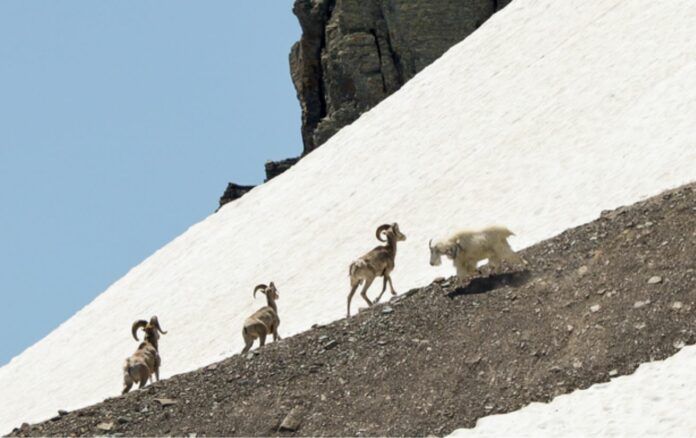A new study by researchers at the Wildlife Conservation Society (WCS), Colorado State University (CSU), and the National Park Service (NPS) reveals high-altitude competitions between two of America’s most spectacular mammals, mountain goats and bighorn sheep, over minerals that were inaccessible before the melting of glaciers.
The study also points to other valuable resources, such as desert water and shade in harsh environments in Africa, Asia, and North America. Species in these harsh environments compete for access to these biologically important resources, but these interactions have never been recorded by individual species, their size, or their status as “native” or “exotic.”
Joel Berger, the lead author and Senior Scientist for WCS and the Barbara Cox-Anthony Chair of Wildlife Conservation at Colorado State University, said, “while humans continue to be justifiably concerned about the climate-induced havoc we’re wreaking planet-wide, much has remained unknown about species aggression among our mammalian brethren.”
The results of this study were based on bits and pieces of information from the past 40 years. They included species as different as marmots and baboons, oryx and elephants, rhinos, and wild (also called feral) horses, which pushed out native pronghorn, mule deer, and elk from desert waters.
The study found that at three sites over a 900-mile gradient of the above-treeline mountainous environment from Colorado to Alberta, Canada, mountain goats with their saber-like horns defeated bighorn sheep in more than 98 percent of battles. Although they are a natural species in the northwest of North America, mountain goats are considered exotic in Colorado and Wyoming, including the Greater Yellowstone Ecosystem, where they were first introduced. Concerns have been raised in one region as well as in others about the degree to which goats could displace or outcompete native bighorn sheep. Although it is unknown whether interactions to access resources have increased over time as our climate degrades, human activity has both increased and decreased wildlife access to restricted resources such as minerals and water through the construction of roads and the creation of artificial water sources.
This research was published in the peer-reviewed academic journal Frontiers in Ecology and Evolution. Co-authors Forest Hayes, a PhD student at CSU, and Mark Biel, chief biologist at Glacier National Park in Montana, noted that while bighorns and mountain goats have been known to travel up to fifteen miles or more to access scarce resources, high-elevation aggression between species, whether passive or active, highlights the importance of scarce resources. To reach far-off waterholes in Namibia, desert elephants travel even further distances — up to 40 kilometres.
“It’s been exciting to gather data in wind, snow, and cold on goats and sheep in both Glacier and at Mt. Evans, Colorado, which reaches to more than 14,000 feet,” said Forest Hayes.
“Our observations both at close range and from distances of more than a mile provided unique opportunities for detecting and understanding ecological interactions.”
Berger, Biel, and Hayes indicate that climate change may play a role in ground water depletion in desert places, but they understand that humans may be a more urgent threat, as water use for people increasingly jeopardizes the fragility of biodiversity in these systems.
“If we can’t offer species other than ourselves a chance, we’re just cooking our fates along similarly destructive paths” added Berger.
Source: 10.3389/fevo.2022.991714
Image Credit: Getty
You were reading: Extreme Environs Turn America’s Most Sensational Mammals Violent
